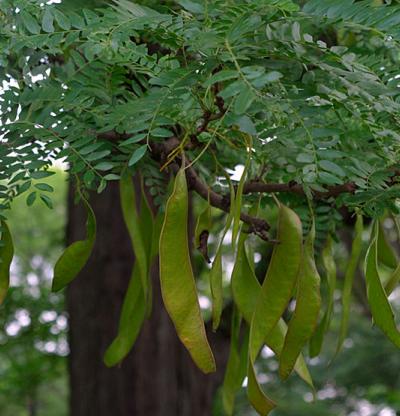





 Honeylocust (Gleditsia triacanthos)
gled-IT-see-ah try-ah-KAN-thos
Genus:
Gleditsia
Honey locust grows in the wild from Pennsylvania to Iowa and south to Georgia and Texas. In the landscape, this large, spreading, deciduous tree is valuable for its elegant form and pinnate, ferny leaves that cast a dappled shade. Flowers are generally inconspicuous, but are followed by unusual large seed pods. Fall color can be a nice yellow, but leaves sometimes fall without noticeably changing colors. The species has a thorny trunk and shoots, but thornless cultivars are available.
Noteworthy Characteristics:
Native to the eastern and central U.S. Ferny foliage doesn't produce heavy leaf litter. Interesting seed pods that look like large, twisted pea pods. Adaptable to a variety of growing conditions.
Care:
This native tree is adaptable to any fertile, well-drained soil in full sun.
Propagation:
Scarify seed and sow in containers in fall in an open frame. Cultivars can be budded in summer or grafted in late winter.
Problems:
Tar spot, powdery mildew, twig and trunk canker, leaf spot, heart rot, and mushroom root rot are possible problems, as are caterpillars, mites, aphids, borers, webworms, honeylocust pod gall midges, honeylocust plant bugs, scale insects, and plant hoppers.
Honeylocust (Gleditsia triacanthos)
gled-IT-see-ah try-ah-KAN-thos
Genus:
Gleditsia
Honey locust grows in the wild from Pennsylvania to Iowa and south to Georgia and Texas. In the landscape, this large, spreading, deciduous tree is valuable for its elegant form and pinnate, ferny leaves that cast a dappled shade. Flowers are generally inconspicuous, but are followed by unusual large seed pods. Fall color can be a nice yellow, but leaves sometimes fall without noticeably changing colors. The species has a thorny trunk and shoots, but thornless cultivars are available.
Noteworthy Characteristics:
Native to the eastern and central U.S. Ferny foliage doesn't produce heavy leaf litter. Interesting seed pods that look like large, twisted pea pods. Adaptable to a variety of growing conditions.
Care:
This native tree is adaptable to any fertile, well-drained soil in full sun.
Propagation:
Scarify seed and sow in containers in fall in an open frame. Cultivars can be budded in summer or grafted in late winter.
Problems:
Tar spot, powdery mildew, twig and trunk canker, leaf spot, heart rot, and mushroom root rot are possible problems, as are caterpillars, mites, aphids, borers, webworms, honeylocust pod gall midges, honeylocust plant bugs, scale insects, and plant hoppers.
Copyright © www.100flowers.win Botanic Garden All Rights Reserved